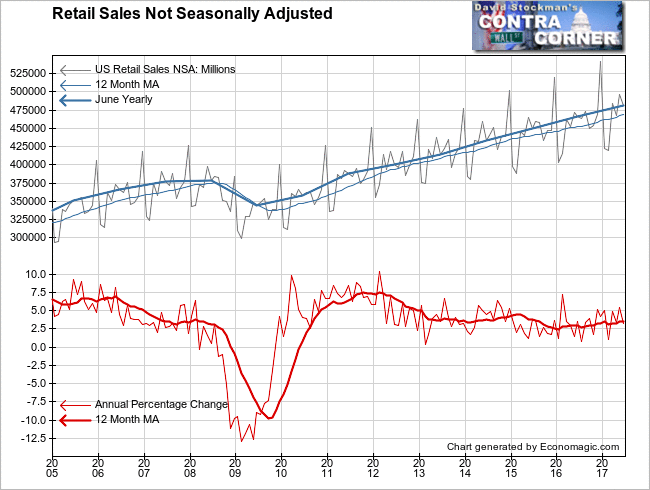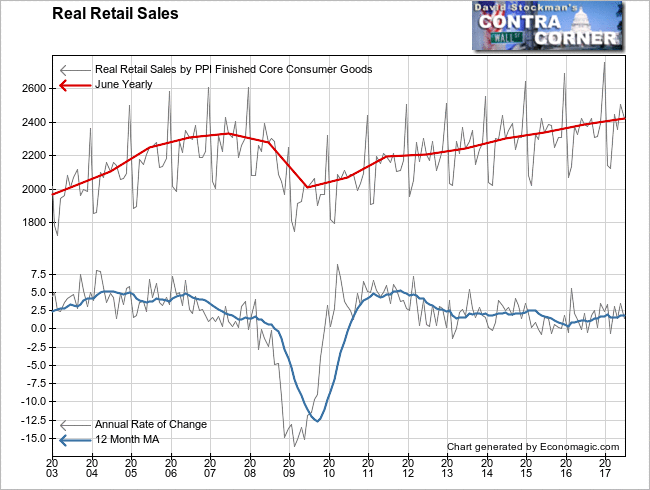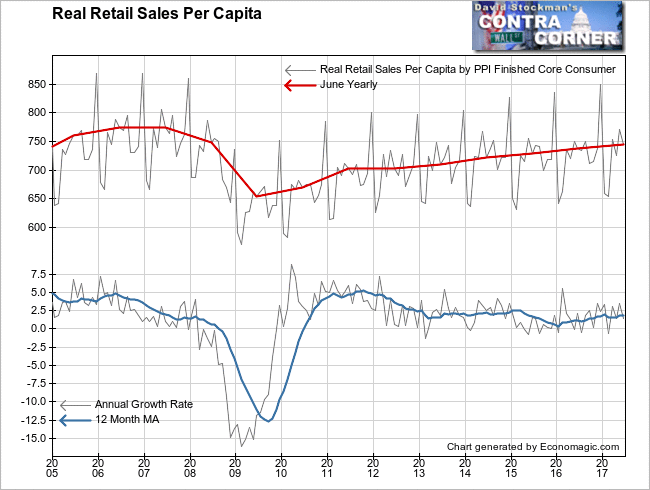“More Bad News for Retailers” was the Wall Street Journal’s glum headline on the Commerce Department report on June US retail sales last week.
“Sales stay weak at stores and now they can’t raise prices to offset higher costs,” the Rupert Murdoch run newspaper added.
Retail sales were weak last month. The Commerce Department on Friday reported that overall sales in June fell 0.2% on the month after slipping 0.1% in May. Compared with a year earlier, they were up just 2.8%.
Digging into the details of the report didn’t make it look any better.
That was all as according to the financial newspaper of record. As usual, we do our own digging to find out if the headline story holds water.
The Wall Street Journal, and in fact all of the mainstream media, only reports the seasonally adjusted (SA) artistic impression of the monthly and annual change. We prefer the actual, unmanipulated data. We can easily tell how weak or strong the month was by comparing it with the same month in years past.
Whereas the mainstream media reports all showed the Census Bureau’s seasonally adjusted decline of 0.2% in June, the actual change was a drop of -3.2%.
But is that bad? Actually it was bang on the 10 year average change for the month of June. However, it was worse than June 2016’s drop of -1.2%.
The year to year growth was 3.2% on an actual, NSA basis. The Journal reported year over year growth using the SA data to compare June of this year with June of last year. Obviously, it’s indefensible to compare the same month in different years on the basis of seasonally adjusted data. There is no difference in seasonality in comparing the same period. It’s a comparison of two fictitious numbers. Why the media persists in constantly misreporting the annual growth rate on this basis is just one of those mysteries of financial journalism.
But what about a 3.2% growth rate? Is that so bad? Not really. It’s right at the middle of the annual growth rate range of the past year, which has ranged from a low of 1% in February, to a high of 5.4% in May. There’s just nothing unusually weak about the June number.

So it wasn’t quite the mournful news that the WSJ represented. The trend has been very stable on an absolute basis, but growth momentum has been slowing since the initial burst 2 year burst off the recession lows.
In addition, these numbers do include inflation. Once you back that out, the long term trend of retail sales is far less impressive.
Nominal retail sales rose 3.2% over the past 12 months, and 6.9% over the past 2 years. They are up an impressive 27.7% since the previous cyclical peak in 2007. But adjusted for inflation, they were up just 1.5% in the past year and 3.6% in the past 2 years. That’s not great, but at least it’s positive. The total gain since the 2007 peak is 3.7%. Only in the past 2 years has the volume of sales exceeded the 2007 peak.

It gets worse. Considering population growth, on a per capita basis there has been no growth in retail sales whatsoever since 2008 when the economy was in recession. The annual growth rate in per capita retail spending was 0.8% over the past 12 months. The 2 year gain was 2.2%. But that still leaves per capita sales below the 2007 peak by 3.9%. On average, Americans are buying less retail goods than they were 10 years ago.

We know that those in the upper income strata have done well. This would add to the per capita retail spending average. That means that the lower 90% who are not experiencing strong income gains, while facing rapidly rising costs of housing and medical care, have probably had an even bigger drop in spending. The question becomes how long US retail businesses can stand this trend of the hollowing out of their customer bases without seeing revenues and profits fall sharply.
So the Wall Street Journal was right for the wrong reasons. There’s good reason to be doleful about retail sales. Following an initial rebound off the 2008-09 recession lows, real retail sales per capita have only grown by a total of 0.7% over the past 6 years, and that has been with the help of strong gains from high income consumers.
This trend is nothing new. Retail sales growth has been weak since the bungee rebound from the recession. Online sales have been booming, but not enough to offset the shrinkage of traditional brick and mortar stores. High income consumers have certainly been spending more, but the per capita average of sales has barely budged. A few years ago, this weakness was part of the reason that the Fed held off on tightening monetary policy.
But the Fed began to change its tune earlier this year. It made its intent to start shrinking its balance sheet and draining funds from the markets and the banking system part of official policy after the June FOMC meeting. It didn’t say exactly when, but it did say how, and that became part of the official record of the Fed, along with the threat that the draining would begin “soon.” “Experts” from Primary Dealers who are plugged into the Fed, have mostly opined that it would begin in September.
There’s nothing in the weak retail sales trend that would change that. It’s the same trend we have been in for the past 6 years since that first bounce off the lows. If the Fed changes its mind, it will need to find another excuse. In the absence of news showing greater weakness in retail sales, or surprising weakness in a different economic sector, I’d still bet that the Fed will start draining funds from the markets later this year. That will be bad news for both stocks and bonds.


